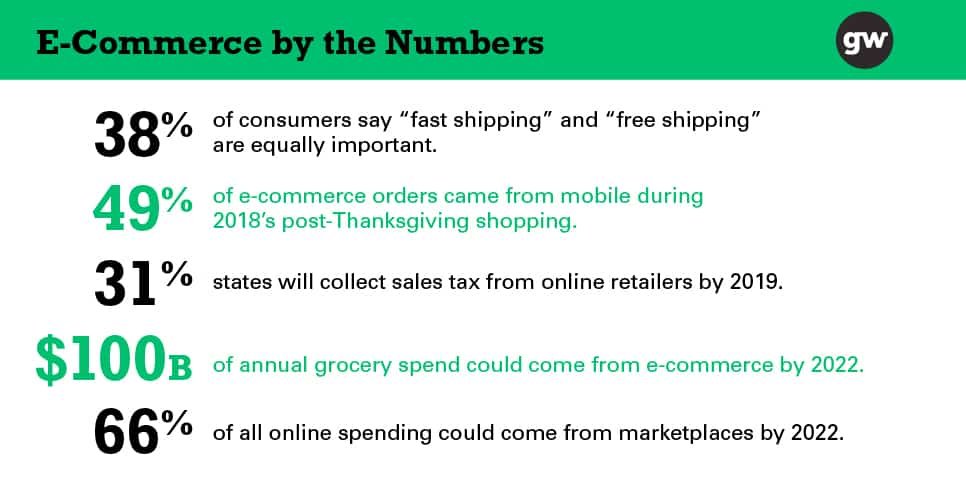By Ian McCue, senior associate content manager at NetSuite. This article originally appeared on growwire.com.

Online retailers have reason to feel optimistic as they turn the page to 2019.
“Cyber 5,” otherwise known as the five-day online shopping period from Thanksgiving through Cyber Monday, is a bellwether of e-commerce holiday revenues. This year brought good news: “Cyber 5” sales far exceeded predictions, totaling $22.5 billion, per Internet Retailer estimates. That’s a jump of more than 19 percent from last year.
In general, online sales continue to grow 10 percent or more year-over-year. Heading into what should be a lucrative new year, here are a few trends that will likely shape the e-commerce landscape:
1. Faster shipping (membership programs included)
Although free shipping remains king, consumers are starting to care more about speed. About 38 percent of shoppers put equal value on free shipping and fast shipping. The emphasis on speed will keep growing due to the “Amazon Prime effect,” and retailers are taking note. Target offered free two-day shipping for about seven weeks leading up to Christmas to attract business during that critical stretch. And Walmart recently extended free two-day shipping on orders of $35 or more to many items from its third-party marketplace in an effort to steal business from Amazon and other top competitors.
If an e-commerce shop doesn’t find a way to support fast shipping that is either cheap or free, it risks losing customers to competitors. If budget is tight, your business might consider charging fees for a membership program that includes expedited shipping, à la Amazon Prime.
2. State tax changes
In June, the Supreme Court ruled that states can collect sales tax from online purchases their residents make, even if the business they purchased from doesn’t have a physical presence in the state. Some states have already capitalized on this decision, and others are still enacting changes. By Jan. 1, 2019, 31 states will be collecting sales tax from online retailers.
Many state laws around this establish a threshold–such as $100,000 in sales or 200 transactions–before allowing businesses to collect sales tax, but they vary. (Mississippi and Alabama have a $250,000 threshold, for example, while thresholds in Idaho and Oklahoma are only $10,000). Like many legal issues, it’s complicated and messy.
Even if they collected sales tax prior to the Supreme Court ruling, e-commerce shops nationwide will likely need to adjust their practices in the new year, since the new laws vary by state. E-commerce businesses need to consider the additional resources required for managing these taxes and complying with these laws, things like new software, more employees and expert consultants.
3. Marketplaces
It’s not hard to imagine why online marketplaces are growing in popularity: They allow shoppers to view products from multiple brands at multiple prices, all on one site. But they’ve yet to really take off in the U.S. They generated about $470 billion in America last year, which only seems like a lot if you fail to consider that consumers spent $768 billion on China’s Taobao and TMall alone in 2017.
Forrester predicts that online marketplaces could be responsible for two-thirds of all online spending by 2022.
To keep pace, retailers should consider selling through the nation’s biggest marketplaces (Walmart, Amazon, eBay) as well as smaller ones that fit their niche (like Houzz or Lyst). Large brands or those that target untapped markets might even consider launching their own marketplaces.
There are costs–monetary and otherwise–of selling through a marketplace, like giving the vendor a cut of every sale, monthly fees (in some cases) and lack of brand control. However, increased sales and reaching a new consumer base will likely offset those expenses, especially as marketplaces continue accounting for a larger and larger share of online retail. The bottom line: e-commerce companies need to jump on the marketplace train now to avoid getting left behind.

4. Mobile purchasing
For the past several years, a growing cohort of shoppers has been turning to their smartphones when browsing products, then moving to desktops to complete their orders. During Cyber 5, consumers placed 49 percent of orders on mobile, and from Nov. 1-Dec. 6 mobile sales grew an impressive 55 percent year-over-year. It’s a clear sign of growth to come.
Thus, it’s now more critical than ever to optimize e-commerce sites for mobile. Retailer sites must not only render properly on a small screen but also include mobile-friendly menus and checkout pages. Allowing customers to save addresses and credit card information, for example, is one simple way to improve the user experience for mobile.
5. Offline industries moving online
There are certain items most folks still buy in stores, like groceries, cars and high-end jewelry. But that’s changing as consumers grow more comfortable with and accustomed to buying online.
Take groceries, for example. There is little consensus on how much grocery spending happens online–studies estimate anywhere from 2 percent to 5 percent–but there is agreement that the amount is rising quickly. In four years, e-commerce could feasibly account for 20 percent of all grocery spend–that’s $100 billion!
Other categories are ramping up similarly. For example, it’s now possible to buy a car without ever stepping foot in a dealership. Online marketplaces Carvana and Vroom allow customers to find and finance a car entirely online, then deliver it to their doors. Customers have seven days to test out their new ride and return it at no cost. And in the fine jewelry category, online storefronts that specialize in certain types of jewelry, like Blue Nileand James Allen for engagement rings, are seeing their revenue climb quickly.
Retailers in these in brick-and-mortar-focused industries must create a long-term plan for digital commerce to stay relevant in the years to come. Simply having a website is not enough–online stores must offer easy site navigation, rich product pages replete with information and pictures and a simple checkout process. These businesses should also marry the online and in-person experiences by allowing customers to purchase something online and pick it up in store or schedule an in-person appointment online, for example.
🌱 The bottom line
E-commerce businesses should take comfort in knowing theirs remains a robust, expanding market. They don’t need to rethink their business models in 2019; they only need to find ways to adapt to these trends. As consumer preferences change, so must e-commerce companies.



Leave a Reply